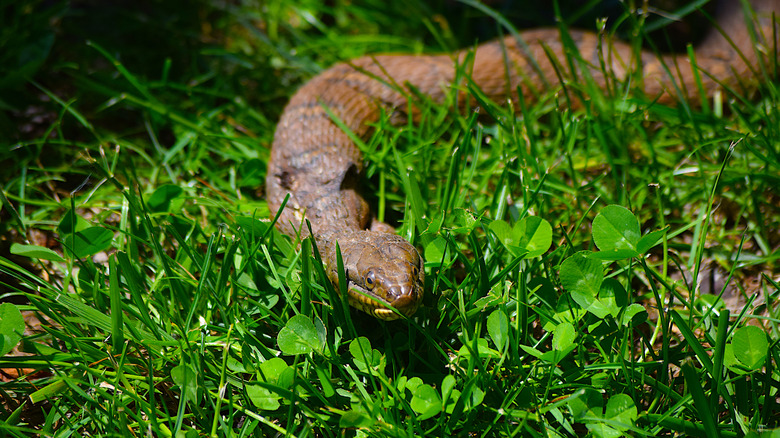Squirrel Hole Vs Snake Hole: How Can You Tell The Difference?
Part of the joy of having a yard is getting to share it with wildlife. But even though you may enjoy attracting birds to your birdhouse or watching hummingbirds at a feeder, you should draw the line at letting animals create holes all over your yard. Holes can be made by a wide variety of critters, but squirrels and snakes are two of the more common culprits. While their holes may look similar at first glance, you can often tell the difference based on the diameter and depth of the hole. Keep in mind that snakes can take over holes and burrows that were made by other animals, so you may need to search around the entrance to the hole for clues on who lives there now.
While some squirrel or snake holes may not immediately seem like a major problem, both squirrels and snakes can be pests in the garden. Squirrels are notorious for digging up bulbs and destroying garden beds. And while snakes can often be helpful if they eat slugs and snails, there are some species that are venomous. Additionally, the holes that these animals make can damage your lawn and plants, and even worse, become a dangerous tripping hazard.
Identifying and dealing with squirrel holes
Not all squirrels dig burrows. Gray squirrels and other tree squirrels often just dig shallow holes to bury or unbury nuts and bulbs, which can easily be covered back up. So if the holes you are noticing are more like divots that are wide at the top before quickly narrowing to nothing, you may be looking at tree squirrel damage.
Of course, tree squirrels aren't the only kinds of squirrels. Ground squirrels like thirteen-lined ground squirrels live in full burrows they dig. These holes are generally very neat and tidy and may be found in pairs. They generally have a diameter between 2 and 4 inches, depending on the specific species.
You can generally keep ground squirrels from digging in your garden by cleaning up any debris in your yard, which attract them. If the problem is severe, contact a certified pesticide applicator who can fumigate or apply pesticides. While it is difficult to prevent tree squirrels from leaving holes all over your yard, some people are able to repel them by applying pepper flakes to any areas the squirrels are regularly damaging. Covering areas that you don't want dug up with hardware cloth or mesh can also help keep squirrels away.
How to identity a snake hole and what steps to take next
Because snakes often move into burrows created by other animals, it can sometimes be difficult to identify a hole that is being inhabited by these slithering creatures. Snakes have a preference for holes that widen as they go down and are between half an inch and several inches in size. However, often, the best way to tell if a snake is living somewhere in your yard is to look for snake tracks and shed skins nearby.
If you don't want snakes living in your garden, you can opt to cover the holes with burlap or mesh to keep the snakes out. Keeping your yard free from debris and tall grass that snakes can hide in should also help limit the number of these unwanted visitors that you get. And of course, you can always contact a pest control professional if you are concerned about dangerous snakes in your yard, like some of the black snakes common in places like Florida.


